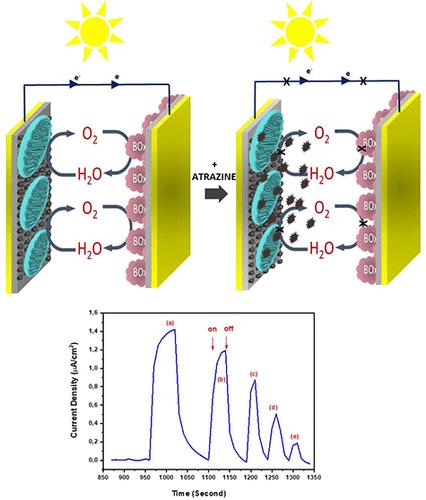Our official English website, www.x-mol.net, welcomes your feedback! (Note: you will need to create a separate account there.)
Construction of a Conductive Polymer/AuNP/Cyanobacteria-Based Biophotovoltaic Cell Harnessing Solar Energy to Generate Electricity via Photosynthesis and Its Usage as a Photoelectrochemical Pesticide Biosensor: Atrazine as a Case Study
ACS Omega ( IF 4.1 ) Pub Date : 2024-03-27 , DOI: 10.1021/acsomega.3c10308 Mustafa Buyukharman 1 , Ibrahim Ender Mulazimoglu 2 , Huseyin Bekir Yildiz 3, 4
ACS Omega ( IF 4.1 ) Pub Date : 2024-03-27 , DOI: 10.1021/acsomega.3c10308 Mustafa Buyukharman 1 , Ibrahim Ender Mulazimoglu 2 , Huseyin Bekir Yildiz 3, 4
Affiliation

|
In this research, a cyanobacteria (Leptolyngbia sp.)-based biological photovoltaic cell (BPV) was designed. This clean energy-friendly BPV produced a photocurrent as a result of illuminating the photoanode and cathode electrodes immersed in the aqueous medium with solar energy. For this purpose, both electrodes were first coated with conductive polymers with aniline functional groups on the gold electrodes. In the cell, the photoanode was first coated with a gold-modified poly 4-(2,5-di(thiophen-2-yl)-1H-pyrrol-1-yl)benzamine polymer, P(SNS-Aniline). Thioaniline-functionalized gold nanoparticles were used to provide a cross-link formation with bis-aniline conductive bonds with the conductive polymer using electrochemical techniques. Leptolyngbia sp., one of the cyanobacteria that can convert light energy into chemical energy, was attached to this layered electrode surface. The cathode of the cell was attached to the gold electrode surface with P(SNS-Aniline). Then, the bilirubin oxidase (BOx) enzyme was immobilized on this film surface with glutaraldehyde activation. This cell, which can use light, thanks to cyanobacteria, oxidized and split water, and oxygen was obtained at the photoanode electrode. At the cathode electrode, the oxygen gas was reduced to water by the bioelectrocatalytic method. To obtain a high photocurrent from the BPV, necessary optimizations were made during the design of the system to increase electron transport and strengthen its transfer. While the photocurrent value obtained with the designed BPV in optimum conditions and in the pseudosteady state was 10 mA/m2, the maximum power value obtained was 46.5 mW/m2. In addition to storing the light energy of the system, studies have been carried out on this system as a pesticide biosensor. Atrazine biosensing via the BPV system was analytically characterized between 0.1 and 1.2 μM concentrations for atrazine, and a very low detection limit was found as 0.024 μM. In addition, response time and recovery studies related to pesticide biosensor properties of the BPV were also investigated.
中文翻译:

利用太阳能通过光合作用发电的导电聚合物/金纳米粒子/蓝细菌生物光伏电池的构建及其作为光电化学农药生物传感器的用途:以莠去津为例
在这项研究中,设计了一种基于蓝藻( Leptolyngbia sp.)的生物光伏电池(BPV)。这种清洁能源友好的 BPV 通过太阳能照射浸入水介质中的光电阳极和阴极电极而产生光电流。为此,两个电极首先在金电极上涂有带有苯胺官能团的导电聚合物。在电池中,光电阳极首先涂有金改性的聚 4-(2,5-二(噻吩-2-基)-1H-吡咯-1-基)苯胺聚合物 P(SNS-苯胺)。使用电化学技术,使用硫代苯胺官能化的金纳米颗粒与导电聚合物形成双苯胺导电键的交联。Leptolyngbia sp.是一种可以将光能转化为化学能的蓝细菌,它附着在这个层状电极表面。电池的阴极用 P(SNS-苯胺) 连接到金电极表面。然后,通过戊二醛活化将胆红素氧化酶(BOx)固定在该膜表面。这种电池可以利用蓝细菌的光,氧化和分解水,并在光阳极获得氧气。在阴极电极,通过生物电催化方法将氧气还原为水。为了从 BPV 获得高光电流,在系统设计过程中进行了必要的优化,以增加电子传输并强化其传输。当设计的BPV在最佳条件和伪稳态下获得的光电流值为10 mA/m 2时,获得的最大功率值为46.5 mW/m 2。除了存储系统的光能外,还对该系统作为农药生物传感器进行了研究。通过 BPV 系统进行的莠去津生物传感在 0.1 至 1.2 μM 浓度之间进行了分析,发现检测限非常低,为 0.024 μM。此外,还研究了与 BPV 农药生物传感器特性相关的响应时间和回收率研究。
更新日期:2024-03-27
中文翻译:

利用太阳能通过光合作用发电的导电聚合物/金纳米粒子/蓝细菌生物光伏电池的构建及其作为光电化学农药生物传感器的用途:以莠去津为例
在这项研究中,设计了一种基于蓝藻( Leptolyngbia sp.)的生物光伏电池(BPV)。这种清洁能源友好的 BPV 通过太阳能照射浸入水介质中的光电阳极和阴极电极而产生光电流。为此,两个电极首先在金电极上涂有带有苯胺官能团的导电聚合物。在电池中,光电阳极首先涂有金改性的聚 4-(2,5-二(噻吩-2-基)-1H-吡咯-1-基)苯胺聚合物 P(SNS-苯胺)。使用电化学技术,使用硫代苯胺官能化的金纳米颗粒与导电聚合物形成双苯胺导电键的交联。Leptolyngbia sp.是一种可以将光能转化为化学能的蓝细菌,它附着在这个层状电极表面。电池的阴极用 P(SNS-苯胺) 连接到金电极表面。然后,通过戊二醛活化将胆红素氧化酶(BOx)固定在该膜表面。这种电池可以利用蓝细菌的光,氧化和分解水,并在光阳极获得氧气。在阴极电极,通过生物电催化方法将氧气还原为水。为了从 BPV 获得高光电流,在系统设计过程中进行了必要的优化,以增加电子传输并强化其传输。当设计的BPV在最佳条件和伪稳态下获得的光电流值为10 mA/m 2时,获得的最大功率值为46.5 mW/m 2。除了存储系统的光能外,还对该系统作为农药生物传感器进行了研究。通过 BPV 系统进行的莠去津生物传感在 0.1 至 1.2 μM 浓度之间进行了分析,发现检测限非常低,为 0.024 μM。此外,还研究了与 BPV 农药生物传感器特性相关的响应时间和回收率研究。



























 京公网安备 11010802027423号
京公网安备 11010802027423号